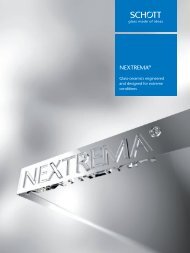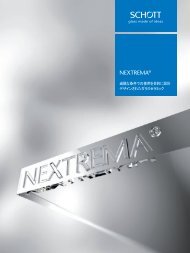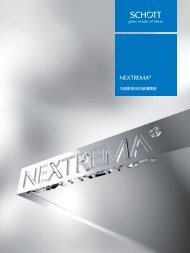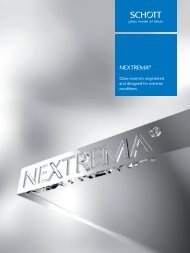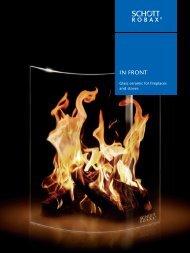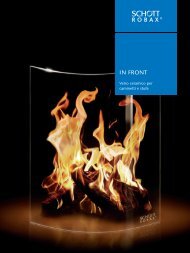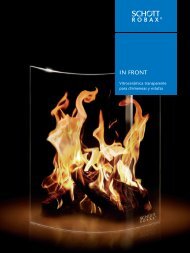SCHOTT Technical Glasses
Apart from its application in optics, glass as a technical material has exerted a formative influence on the development of important technological fields such as chemistry, pharmaceutics, automotive, optics, optoelectronics and information technology. SCHOTT Technical Glasses offers pertinent information in concise form. It contains general information for the determination and evaluation of important glass properties and also informs about specific chemical and physical characteristics and possible applications of the commercial technical glasses produced by SCHOTT. With this brochure, we hope to assist scientists, engineers, and designers in making the appropriate choice and make optimum use of SCHOTT products.
Apart from its application in optics, glass as a technical material has exerted a formative influence on the development of important technological fields such as chemistry, pharmaceutics, automotive, optics, optoelectronics and information technology. SCHOTT Technical Glasses offers pertinent information in concise form. It contains general information for the determination and evaluation of important glass properties and also informs about specific chemical and physical characteristics and possible applications of the commercial technical glasses produced by SCHOTT. With this brochure, we hope to assist scientists, engineers, and designers in making the appropriate choice and make optimum use of SCHOTT products.
Create successful ePaper yourself
Turn your PDF publications into a flip-book with our unique Google optimized e-Paper software.
39<br />
Powder Blasting shape<br />
ØB<br />
A<br />
ØC<br />
Hole<br />
A: hole angle (based on B and C)<br />
B: inlet diameter<br />
C: outlet diameter<br />
Glass<br />
Thickness<br />
US-Lapping shape<br />
Hole<br />
Glass<br />
Thickness<br />
Cavity by Powder Blasting<br />
Glass<br />
Thickness<br />
Structured glass wafer<br />
Radius at the edges<br />
Applications of structured glass wafers and substrates with<br />
holes and cavities are in the electronics industry, e.g. for<br />
MEMS capping wafers and in the biotech industry, e.g. for<br />
flow cells for blood analysis. The two major technologies<br />
currently applied by <strong>SCHOTT</strong> for structuring and their<br />
technical capabilities are:<br />
For processing of ultra-thin glass, new laser-based processes<br />
are under design to cut the glass but also to generate a high<br />
number of holes with diameters around 50 microns as TGVs<br />
(through glass vias) in printed circuit board and interposer<br />
applications.<br />
Ultrasonic lapping<br />
Powder blasting<br />
Size 100 mm to 200 mm Max. 400 mm x 400 mm<br />
Thickness range 0.4 mm up to 3 mm 0.05 mm up to 3 mm<br />
Different hole<br />
configurations<br />
Positioning<br />
tolerances<br />
Min. hole<br />
diameter<br />
Round holes<br />
* Tighter tolerances upon request<br />
± 65 µm* ± 65 µm*<br />
0.4 mm 0.1 mm<br />
Round, rectangular holes<br />
and caverns<br />
8<br />
Table 8. Structured technologies and technical capabilities<br />
Flow cell for DNA analysis, structured into <strong>SCHOTT</strong> thin glass<br />
TGV technology with <strong>SCHOTT</strong> AF 32 ® eco 100 µm ultra-thin glass<br />
processed by excimer laser at 193 nm wavelength






